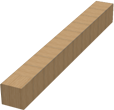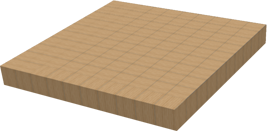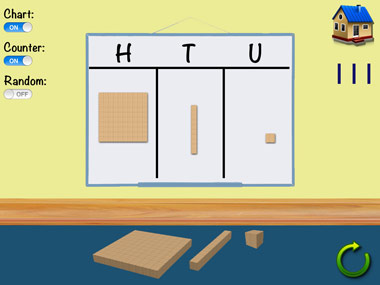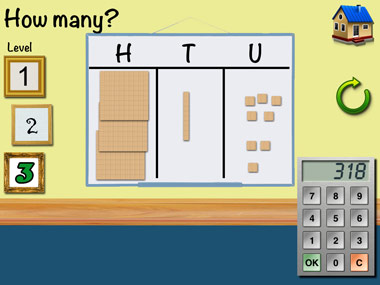Place Value MAB
Little Monkey Apps Place Value compliments the use of hands on experiences for modelling numbers using MAB blocks. It is beneficial in instances when using real blocks is not practical.
MAB or Multibase Arithmetic Blocks are wooden blocks used to help children understand the base ten properties of the numerical system. MAB encourages students physically manipulate blocks to create, build, model and explain the place value of a number.
Depending on which school, educational system, state or country you belong to MAB blocks or base ten blocks have various names.
1 short, mini, unit, U= one (1)
 1 long, stick, T = 1 ten (10)
1 long, stick, T = 1 ten (10) 1 flat, H = 1 hundred (100)

MAB can also be placed on a place value chart to aid with visualising and correctly aligning the place of each number.
Place value materials sequence
MAB is one way of teaching place value and should not be the only equipment used in teaching place value. For early counters real world materials should be used such as toys, teddies, marbles and beans. This should be followed by more abstract means like counters and unifix to model REAL worded problems.
Before commencing with MAB, students should use icy pole sticks, straws, pencils or joined unifix with which bundles of ten can be made. Through use of variety of equipment, students will come to establish that a bundle is always ten and ten bundles of ten are one hundred. MAB is more abstract and should be introduced as students are ready.
Little Monkey Apps Place Value is separated into a teaching module and three corresponding activities to aid children in building, modelling and reading numbers. There are three levels within each area to provide for a range of abilities. The app is designed to be used with an educator or tutor in individual or small group teaching situations followed by independent work by the student.
Teaching Module

This section provides MAB, a removable place value chart, removable number display and removable random number generator for playing games.
The teaching module is to be used with a teacher or tutor with interaction to discuss or investigate real problems.
Example
I counted twelve red cars, can you use the blocks to show twelve? Is there another way to show twelve? (twelve units or one long and one unit) Which one is correct? Can you swap ten of those units for a long? What is the number after that/before that/ten more than that. Do you need to count the ones out if I add ten more cars?
Idea for a game - Race to twenty (or one hundred)
Role the die and make the number e.g. roll a six, make the number, roll again, five, add five units = eleven, trade ten units for one long...keep playing until you reach twenty. How many turns did it take etc.
More challenging game
Press the random number generator and choose flats, longs and units. E.g. generate a three, choose three longs, press again, one, choose one unit, press again, five, choose five flats, read the number 531. Play with a partner, who can make the largest number/smallest number, number closest to a target number etc.
Make the number

Read the numerical number given and use the MAB at the bottom of the screen to model the number given, pressing the answer button when finished. Three levels, Level 1 to 30, Level 2 to 99, Level 3 to 999.
How many?

MAB is at the bottom of the screen, students must unjumble the MAB, placing in the correct position on the Place value chart. They then key in the correct number or the keypad (promoting calculator skills). Three Levels of increasing difficulty.
Listen and Make

Attempts to address numbers in which students make place value errors such as reversals 15 for 51, or omissions 520, 52 for 502 ,3009 for 309 and mishearing 13 for 30.
Students listen to the number then drag the MAB onto the place value chart in the correct position, pressing answer when complete. Three levels of increasing complexity.
Just a hint
The most important thing about place value is the language you use. For example 56 has 5 tens, which is really 50 ones, 590 has 59 tens (not 9), but if you model 590, you might ask, what is the digit in the tens place?
There are many ways to make numbers from MAB, for example 23 could be two longs, three units or one long, thirteen units, or twenty three units. ALL of these are correct and important when addition with regrouping or subtraction with trading begins; however, two longs and three units could make it easier to count or read the number quickly.
Little Monkey Apps Place Value compliments the use of hands on experiences for modelling using MAB blocks it does not and should not replace physical manipulation of real MAB blocks, unifix, sticks, beans or pencils.
Outside resources
- Updated:
- Version:
- 1.01
- iOS:
- Compatible with iPad. Requires iOS 4.0 or later.
- Size:
- 7.5 MB
- Price:
- $1.99